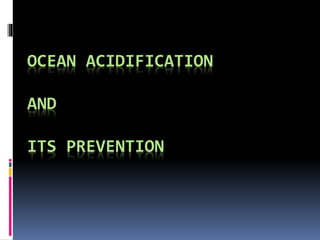Ocean acidification & its prevention
•Download as PPTX, PDF•
1 like•233 views
A study on reasons and prevention of ocean acidification
Report
Share
Report
Share

Recommended
Recommended
More Related Content
What's hot
What's hot (20)
Climate change ,adaptation and mitigation in fisheries

Climate change ,adaptation and mitigation in fisheries
How humans are engaged in altering the environment

How humans are engaged in altering the environment
Marine pollution, its impact on marine life and remedial measures against wat...

Marine pollution, its impact on marine life and remedial measures against wat...
Potential Impacts of Climate Change and Ocean Acidification for the Future of...

Potential Impacts of Climate Change and Ocean Acidification for the Future of...
Environment; Pollution and other environmental problems

Environment; Pollution and other environmental problems
Similar to Ocean acidification & its prevention
Similar to Ocean acidification & its prevention (20)
Water pollution and Marine pollution - for students.pptx

Water pollution and Marine pollution - for students.pptx
triptico la contaminación ambiental en ingles.docx

triptico la contaminación ambiental en ingles.docx
Recently uploaded
Recently uploaded (20)
Fostering Friendships - Enhancing Social Bonds in the Classroom

Fostering Friendships - Enhancing Social Bonds in the Classroom
HMCS Max Bernays Pre-Deployment Brief (May 2024).pptx

HMCS Max Bernays Pre-Deployment Brief (May 2024).pptx
Interdisciplinary_Insights_Data_Collection_Methods.pptx

Interdisciplinary_Insights_Data_Collection_Methods.pptx
HMCS Vancouver Pre-Deployment Brief - May 2024 (Web Version).pptx

HMCS Vancouver Pre-Deployment Brief - May 2024 (Web Version).pptx
Sensory_Experience_and_Emotional_Resonance_in_Gabriel_Okaras_The_Piano_and_Th...

Sensory_Experience_and_Emotional_Resonance_in_Gabriel_Okaras_The_Piano_and_Th...
Python Notes for mca i year students osmania university.docx

Python Notes for mca i year students osmania university.docx
Exploring_the_Narrative_Style_of_Amitav_Ghoshs_Gun_Island.pptx

Exploring_the_Narrative_Style_of_Amitav_Ghoshs_Gun_Island.pptx
Salient Features of India constitution especially power and functions

Salient Features of India constitution especially power and functions
UGC NET Paper 1 Mathematical Reasoning & Aptitude.pdf

UGC NET Paper 1 Mathematical Reasoning & Aptitude.pdf
Ocean acidification & its prevention
- 2. • Ocean acidification • Causes Effects Prevention
- 3. What is Ocean Acidification ? It’s simply pollution by Carbon On going decrease in pH of Earth’s oceans due to uptake of carbon dioxide (CO2) from atmosphere Seawater is slightly basic : pH > 7 When pH value gets shifted towards neutral (pH = 7) acidification results Doesn't mean a shift towards acidic condition (pH < 7)
- 4. What are its Causes ? Carbon dioxide emitted from industries, vehicles etc dissolves in surrounding water bodies – rivers, lakes, seas …. This is about 30 % to 40 % of emitted CO2 Some of these CO2 molecules react with water to form carbonic acid molecules to achieve equilibrium In turn some of these CO2 molecules dissociate in to bicarbonate ions and hydrogen ions (H+) This results in a increase in H+ ions and in turn the ocean acidity
- 5. What are its Impacts ? Increasing acidity has potentially harmful consequences to marine organisms Depressing metabolic rates in jumbo squid Depressing immune response in blue mussels Causing coral bleaching Increasing growth rate of sea star Flourishing of shelled plankton
- 6. Who are the most affected ? Shellfish industries – Loss of job and business Island nations – As these are built on coral, struggle for food and to shelter their coastlines Youth who want a future Renewable energy companies – including solar, wind, and hydro The whole climate change movement – carbon pollution is enemy in both acidification and climate change
- 7. How to Prevent it ? REDUCE YOUR CARBON FOOTPRINT – HOW ? Eat less meat: Livestock farming produces more greenhouse gasses than all forms of transport combined. This is the biggest cause of climate change, and therefore ocean acidification.The lower on the food chain you eat, the less energy is used.Try meatless Mondays Use less energy at home: Make sure your home is well insulated - roof and around windows. Use star rated electrical products, turn off lights, unplug power sources not in use, and use shorter cycles on your dishwasher and washing machine. Switch to green power
- 8. Conserve water: Lots of energy is required to pump, treat and heat water. Watch what you pour down the drain and use eco-friendly products that break down. Reduce your plastic addiction: Avoid bottled water. Refuse straws when you eat out. Adapt to reusable containers. Drink from the tap, filter it and use water canteens to refill. Say no to plastic bags Drive and fly less: Carpool, ride bikes and take public transit Buy less stuff: Manufacturing products and the transportation required to get it to you burns a lot of carbon
- 9. Reduce, reuse, recycle and refuse:This helps conserve energy and reduces pollution and greenhouse gas emissions from resource extraction, manufacturing, and disposal Assess your life, career and lifestyle choices: Is your industry destructive, carbon intensive, polluting or unsustainable? Suggest changes and do what feels right for you and environment Calculate your carbon footprint
- 10. MAKE SMART CONSUMER CHOICES Refuse to use single use plastic bags and campaign to ban them Learn about what all we dump into our oceans that destroy ecosystems. Plastic pollution is a threat for sea life, and is a growing source of chemical pollution in the ocean Plastic never goes away Never buy coral products - we’re losing coral reefs too fast
- 11. ThankYou
